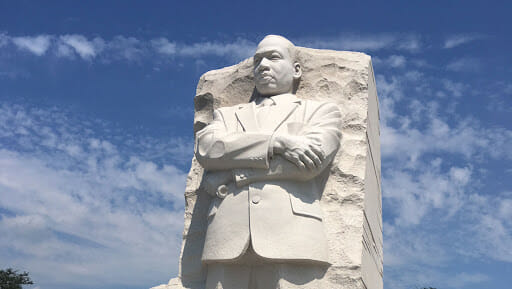“The arc of the moral universe is long, but it bends toward justice.” Martin Luther King Jr. spoke these words on the steps of the Alabama State Capitol on March 25, 1965, at the conclusion of the third of three marches from Selma to Montgomery. Approximately 25,000 people witnessed King’s address, which is now widely known as the How Long, Not Long speech in reference to the repetitive refrain of its climax. “I come to say to you this afternoon,” King declaimed, “however difficult the moment, however frustrating the hour, it will not be long, because ‘truth crushed to earth will rise again.’”
How long? Not long, because “no lie can live forever.”
How long? Not long, because “you shall reap what you sow.”…
How long? Not long, because “mine eyes have seen the glory of the coming of the Lord. His truth is marching on. »
Unlike the similarly repetitive but better known I Have A Dream speech, which entreats its listener to find hope in the future, How Long, Not Long finds hope in the past. It was William Cullen Bryant, a nineteenth-century American poet, who wrote that “truth crushed to earth will rise again.” It was Thomas Carlyle, a nineteenth-century Scottish essayist and historian, who observed of the despotism that preceded the French Revolution that “no Lie can live for ever.” It was Paul, a first-century Jewish proselyte to Christianity, who wrote in his epistle to the Galatians that “a man reaps what he sows.” And it was Julia Ward Howe, a nineteenth-century American abolitionist and poet, who wrote “Mine eyes have seen the glory of the coming of the Lord…. / His truth is marching on.”
The promise of How Long, Not Long is that life gets better, that the human condition improves with time. Hans Rosling certainly believes so. In 2010, the Swedish statistician published 200 Countries, 200 Years, 4 Minutes on YouTube. The video, which has been viewed nearly 10 million times to date, chronicles the steady gains in average income and life expectancy that humanity has achieved during the last two centuries. Steven Pinker is an optimist as well. The thesis of his 2011 book, The Better Angels of Our Nature, is that we are now living in the most peaceful era of our species’ history.
A few years ago, the designer Jack Hagley created The World as 100 People, an infographic that distills Earth’s billions of human residents to a representative 100 and parses them according to various attributes. In many ways, Hagley’s distillation vindicates King’s hopefulness: 83% of people are now literate; 87% consume safe drinking water; 84% have adequate nutrition (indeed, 21% are overweight); 77% have shelter; and 75% even have cell phones. In other respects, however, Hagley’s wheel highlights persistent challenges: 93% of people have no college degree; 70% have no access to the Internet; and 48% survive on less than $2 per day.
At the end of 200 Countries, 200 Years, Rosling qualifies his enthusiasm by noting, for example, that while living conditions have improved in China as a whole, enormous disparities between its urban and rural populations persist. In India, the world’s largest democracy and the beneficiary of extraordinary economic growth since the turn of the century, 94% of marriages still occur within rather than between castes, evidence of deeply entrenched social immobility. In post-apartheid South Africa, 47% of citizens are impoverished. Here in the United States, the median net worth of white households is nearly 10 times the median net worth of Black households.
It was Theodore Parker, a nineteenth-century American Unitarian minister and abolitionist, who first described “the arc of the moral universe” in 1857. “Look at the facts of the world,” he wrote. “You see a continual and progressive triumph of the right. I do not pretend to understand the moral universe, the arc is a long one, my eye reaches but little ways. I cannot calculate the curve and complete the figure by the experience of sight; I can divine it by conscience. But from what I see I am sure it bends towards justice.”
In regression analysis, the coefficient of determination, or R-squared, measures the extent to which a trendline explains variability in a dataset. When R-squared is high, the trendline explains most of the variability, and the individual data points cluster around it; when R-squared is low, it does not, and the data points are spread apart. The arc of the moral universe—the trendline of our common humanity—indeed bends toward justice as Parker declared, and as Rosling, Pinker, and Hagley confirm, but its R-squared coefficient is unacceptably low. The dataset of our species includes too many outliers below the trendline. Too much of the variability of the human experience is unexplained by our arc toward justice. We must do more to elevate our R-squared value. The work begins at places like MICDS.
Always reason, always compassion, always courage. We go to school to make the world a better place. Happy Martin Luther King Jr. Day to you and your families.
Jay Rainey
Head of School
This week’s addition to the “Refrains for Rams” playlist: Proxima B as performed by Benjamin Gibbard. “You and I are gonna get it right. / We won’t make the same mistakes twice.” (Apple Music / Spotify)
